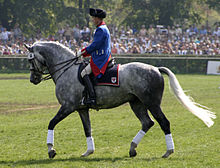Riding skirt
The term riding skirt describes various items of clothing. Mostly a riding jacket with a waist seam is meant, as it is often worn at tournaments. The term skirt is derived from the men's skirt . There are also modern riding skirts with long laps made of thermal material for the winter, which have the advantage of warming the thighs.
In severe dressage tests are Reitfräcke worn.
Hunting skirt
Red show jumping jackets are often referred to as hunting skirts or jumping skirts.
On horseback hunts , however, in addition to normal short riding jackets, hunting skirts with long wool laps are worn, which offer good protection on the hunt for several hours in autumn weather. Experienced male hunting riders can wear a red skirt before Hubertus Day, with the gauntlet boots . All others mostly wear muted colors. Mostly they consist of robust and warm wool, which keeps out both cold and wet. Some hunting horn groups also wear hunting skirts.
Women's riding skirts for normal saddles
There are also wide women's riding skirts and riding dresses with which the rider sits astride a horse with a normal saddle. Such riding skirts are cut very wide, with hem widths around nine meters. This makes the skirt wide enough to be worn over the horse. Such elaborate riding skirts were common among noble horsewomen in Spain in the 17th century. The horse wore a blanket to protect its skirt. Today, such skirts are mostly made of easy-care synthetic fibers and a protective blanket is superfluous. Women's riding skirts for normal saddles are worn with breeches.
There is also a half-width variant, with a long slit at the front and a wide skirt at the back that lies over the croup .
Devantière
In the 17th century, women riders in France wore a garment called devantière . The Devantière's skirt was split and allowed to sit astride a horse.
Portuguese riding skirt
The Portuguese riding skirt is a slim cut variant with long slits in the front and back. The two halves of the skirt are fixed with elastic bands, similar to a riding coat. Such riding skirts with slits are made of heavy fabrics so that they fall well. They are worn with breeches.
Riding trousers
Usually no additional breeches are worn under a riding trouser skirt.
- Spanish riding skirt: a trouser skirt with wide legs that is suitable for normal saddles.
- Western riding skirt: wide trousers, made of wool or leather, often decorated with a button placket that runs the entire length of the leg.
Riding skirts for the side saddle
In the 19th and early 20th centuries, aristocratic women mostly sat in side saddles on horseback - but they obstructed the fabric of their skirts and petticoats, especially on fast rides. Therefore, at the end of the 19th century in England, a special safety skirt , also known as a riding apron , was developed that covered the rider's right foot, but made do with less fabric so as not to hinder the horse riding. Since when riding in the side saddle there is a great risk of getting caught on the horns of the saddle and getting under the horse in the event of a fall, the riding aprons also offered more safety than the previously usual puffy garments. Traditionally, safety riding skirts are made of heavy wool to provide protection from the elements. This classic form of riding skirt is worn at side saddle tournaments. However, the modern variants only reach just above the left ankle, so that the judges can assess the rider's heel posture.
Riding dress for the side saddle
Colored, light, wide and therefore comfortable riding clothes are often used at shows. Normal riding breeches and riding boots are generally worn under riding skirts and riding clothes .
Maria Anna von der Pfalz (1667–1740) , Spanish queen, wearing a riding dress on a normal saddle
Individual evidence
- ↑ Warm rider's legs: Uhip riding skirts ( Memento of the original from June 2, 2013 in the Internet Archive ) Info: The archive link was automatically inserted and not yet checked. Please check the original and archive link according to the instructions and then remove this notice. , Cavallo, December 13, 2012.
- ↑ Elizabeth J. Lewandowski: The Complete Costume Dictionary. Scarecrow Press, Lanham MD et al. 2011, ISBN 978-0-8108-4004-1 , p. 86 .
- ^ Daniel Boileau, The French Remembrancer, Or, a new and easy Method of Recollecting the Genders of the French Nouns Nouns, by Means of a complete analytical Vocabulary of all French Nouns .. T. Cadell, & G. & WB Whittaker, London 1822, p. 315 .
- ↑ Side saddle Germany: The modern wardrobe for the side saddle
- ↑ Elegance in the side saddle: the safety apron and its use




